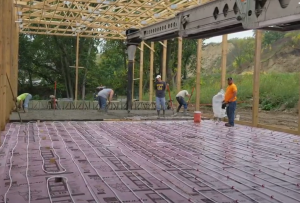Concrete – when cured it normally looks gray and is hard. Not much more to know about it… right?
 Wrong. All concrete is not created equal. Modern concrete mixtures often contain many additives, some of them used to decrease the selling price of the pre-mix, others for strength or curing characteristics.
Wrong. All concrete is not created equal. Modern concrete mixtures often contain many additives, some of them used to decrease the selling price of the pre-mix, others for strength or curing characteristics.
Back in the “olden days”, concrete was ordered from ready-mix suppliers by specifying the number of 94 pound bags of Portland cement which would be added per yard of concrete. Terms like five sack or six sack were very familiar to all involved.
As more cement is added per yard of pre-mix concrete, the compressive strength of the concrete is increased. Compressive strength is measured in PSI (pounds per square inch) which cured concrete can withstand before failure. The psi of a concrete mix is termed in a 28 day strength test. In other words a 3000 psi mix, tested by a lab facility 28 days after being poured, must not fail below 3000 psi of force.
More compressive strength may provide stronger concrete, but is not always the best solution for a particular use. Often contractors will try to “one up” the competition by promoting the use of higher strength concrete than their competitors. Many do not realize high amounts of Portland cement, especially in combination with over hydration (too much water), can result in shrinkage cracks in finished concrete.
On a sidebar – when I was a general contractor, clients would often ask what the guarantee was on concrete slabs in their new pole buildings. My response was, “I will guarantee it will crack”.
What is the best mixture to use? For concrete footings and encasements around the columns of pole buildings, a 3,000 psi mix is usually more than sufficient.
With interior flatwork, like the concrete slab inside a pole building, which is not exposed to freeze and thaw cycles, a 3,000 psi mix without air added will be fine in the great majority of cases.
Outdoor pours, especially when dealing with freezing and thawing cycles, prove to be more of a challenge. To avoid or minimize spalling, Increasing the concrete mixture to 4,000 psi is often recommended. Adding “air” to the mix, as well as using a low slump, helps to avoid spalling.
An experienced local redi-mix company can help with selection of the correct mixtures for any application, so don’t be afraid of utilizing them as a resource.






